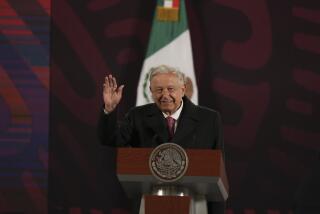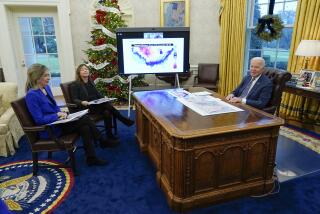Political Novice Winding Up Bid to Dislodge Ortega
- Share via
MASAYA, Nicaragua — For three hours, they had converged on the tiny plaza, thousands of Nicaraguans eager for a glimpse of the gray-haired widow seeking to overturn the young leaders of the Sandinista revolution.
“Come hear Dona Violeta Barrios de Chamorro,” a man shouted into a microphone. “Come hear her message of love and reconciliation, of freedom and democracy.”
“Ortega, you tyrant, your end is near!” the crowd chanted.
Then the main challenger to 44-year-old President Daniel Ortega in Sunday’s election came into view--tall, aristocratic, clad in white and seated in a wheelchair on the back of a pickup truck, covered with a canopy that accentuated her regal bearing.
Suddenly the rhythm changed--”Violeta! Violeta! Violeta!” they screamed--and the truck bogged down in the thickening crowd. Chamorro’s handlers realized they had a maddening logistical problem: How to get the 60-year-old candidate, hobbled by a broken kneecap, to the speaker’s platform two blocks away.
Chamorro’s dramatic entrance to this provincial capital, cradle of the urban guerrilla uprising that brought the Sandinistas to power a decade ago, underscored the hopes and frustrations of her campaign. It is an improvised and troubled effort that has been propelled forward, in spite of itself, on a tide of popular enthusiasm.
Her Nicaraguan Opposition Union, known as UNO, combines 14 parties ranging from Communists to old-line Conservatives in an awkward, 9-month-old coalition that is no match for the Sandinistas’ military efficiency. UNO’s leaders quarrel openly with one another, and the candidate is a political novice whose advisers sometimes wince at her absent-minded, off-the-cuff remarks.
Last month, her campaign nearly disappeared when $3.3 million promised by the U.S. Congress was held up, other funds ran out and Chamorro went to Houston for knee surgery. A week before the election, few billboards or photographs of her are visible in the streets.
But since her comeback in the wheelchair on Jan. 20, she has drawn thousands of people on foot, bicycle and horseback to see her all over the country. Although her rallies are fewer, the turnouts rival those of Ortega, whose party delivers many of its crowds in state-owned trucks.
“Our shortcomings are minor compared to the overwhelming desire for a change in this country, and that is what mobilizes people,” said Emilio Alvarez Montalban, a leading Conservative ideologue. “It is a desire that surpasses the capacity of the politicians.”
On the streets of Managua and other cities, the campaign has brought such sentiment to the surface. When a reporter tried to take an informal poll near Managua’s Eastern Market, he was surrounded by people shouting their grievances against the Sandinistas.
“Viva la UNO!” some yelled.
“We are hungry because they have so many weapons, and that’s what they want us to swallow,” said Teresa Romero, 33, an Eastern Market merchant who voted for Ortega in 1984 but who became disillusioned when the state farm cooperative she belonged to failed. “The best food goes to the army now, and all we eat is leftovers.”
Last September, opposition leaders decided that Chamorro, the widow of a popular newspaper publisher, was the candidate best qualified to mobilize discontent with the Sandinistas and achieve through the ballot box what successive U.S. Administrations and a Contra army had failed to do through economic pressure and counterrevolution.
The murder of Pedro Joaquin Chamorro 12 years ago broadened popular unrest against the Somoza dictatorship that he had vigorously opposed and fueled the Sandinista-led insurrection. When President Anastasio Somoza fled in July, 1979, the young revolutionaries named his widow, along with Ortega, to a five-member governing junta.
She quit nine months later and assumed her late husband’s role as publisher of La Prensa to resist what she called the Sandinista march toward a Marxist-Leninist system and to cultivate his legacy as a lost ideal.
By reaching outside the political parties for Chamorro as their candidate, UNO is trying to turn the election into a referendum on the revolution. She says her government would be less militaristic than Ortega’s, more tolerant of dissent, more reliant on private enterprise, friendlier with the United States and better able to draw international aid to revive the shattered economy.
But the campaign has been hurt by friction in the coalition, caused in part by her reliance on family advisers for election strategy. These tensions surfaced recently when Antonio Lacayo, her son-in-law and campaign manager, engaged in a shoving match with an aide to Virgilio Godoy, her running mate, over who would lead a UNO march.
And her weak grasp of details of major issues has reinforced the impression that, as president, she would be a pawn in a power struggle among factions of an unwieldy movement--one that is already divided over how far to go in reversing the Sandinista revolution.
“I am not a politician,” she tells audiences these days. “But I believe this is a patriotic duty. I have to do this for my country.” At one rally she declared: “I am no dummy.”
In an interview in her study, surrounded by memorabilia of her late husband, she said that she “consults” with him--as she does with God and the Virgin Mary--on important decisions but trusts her own instincts, which she says include the knack for finding hidden water with a divining rod. People close to her say she is a shrewd judge of character.
The Sandinistas understand Chamorro’s popularity and rarely attack her directly. Ortega doesn’t even mention her and calls President Bush his real electoral foe. The Sandinista news media calls her Violeta Barrios, omitting the Chamorro name. The ruling party focuses its criticism on UNO’s embrace of former Contras and Somoza supporters--who are well represented at its rallies, alongside former Sandinistas and ordinary Nicaraguans who became disillusioned with the revolution.
“The UNO brings together all the political enemies of my father,” Chamorro’s Sandinista daughter, Claudia Lucia, wrote in an article last November. “The partisans of the Somoza government have found refuge there.”
But that criticism, which relatives say hurt Violeta deeply, only seemed to emphasize one of her assets as a candidate, her image as a suffering matriarch trying to reunify a divided family and country. She has two adult children in each camp.
“The people of Nicaragua are looking for a caring woman,” said Pedro Joaquin Chamorro Barrios, her elder son, a former Contra leader now advising the campaign. “During these 10 years, people have been fed up with the propaganda of hate and war, and so here comes this woman who has gray hair and a divided family and doesn’t have hate in her discourse.”
After her truck had slowly wedged through the parting crowd in Masaya and aides hoisted Chamorro onto the platform, a silence fell over the sea of faces looking expectantly at her. It was an older audience than those drawn to Ortega’s rallies, with a larger proportion of housewives.
Godoy, the caustic Liberal politician running for vice president, had just riled them with a fiery “forgive but never forget” speech vowing to make the Sandinistas “pay the bill” for the “offenses, abuses, misery and death . . . sown in all the streets, barrios and highways of the republic in these 10 years.”
But Chamorro’s message was conciliatory. She was eager to assure Sandinista soldiers that her plans to reduce the army would not leave them unemployed. And she warned, over a scattered cry of protests, against a spirit of revenge.
“The soldiers can stay,” she said. “They are going to be educated, not persecuted. We don’t want arms, wars or more violence. Everyone will be pardoned, because we are all families. Because many of us have relatives in the government. Because we need to pardon each other. On the 25th of February, we will celebrate by reaching out to each other.”
On Sunday, Chamorro drew more than 40,000 people to Managua’s Revolution Square for her closing campaign rally, the largest anti-Sandinista gathering ever. Hundreds of thousands more listened to a live hookup of seven independent radio stations and scores watched from atop the ruins of Managua’s earthquake-destroyed cathedral, which was draped with huge white and blue banners bearing the name Violeta.
“The votes of the Nicaraguan people will topple the wall of shame built by the Sandinistas, just as the German people toppled the Berlin Wall,” she declared. “Winds of change are blowing through the world. We will not be left in the past.”
The large turnout at such rallies belies most of the polls, which make Chamorro the underdog. But UNO strategists believe that a majority of the 1.7 million voters prefer Chamorro and need only to be convinced that their vote matters, a tall order in a country with no tradition of free elections.
This can be done, they say, by getting her to as many towns as possible--not by matching Ortega’s onslaught of TV advertising, billboards, direct mail and giveaways--and by training enough poll watchers to prevent fraud at each of the 4,394 voting stations.
Heavily outmanned and outspent by the Sandinistas, UNO has been hard pressed to do even that. But its campaign has picked up steam with the belated flow of U.S. aid. Chamorro and Godoy have visited 108 towns, while Ortega and his running mate, Sergio Ramirez, have been to all 143 at least once.
“To convince people to vote for Violeta and not for Daniel Ortega, we had to convince them that their vote is secret,” said Alfredo Cesar, a former Contra leader advising the Chamorro campaign. “We had to get them to lose their fear of the dictatorship. It is difficult to lose your fear watching a TV ad. But seeing Dona Violeta challenge the (Sandinista) Front in your town makes you lose fear.”
More to Read
Sign up for Essential California
The most important California stories and recommendations in your inbox every morning.
You may occasionally receive promotional content from the Los Angeles Times.









